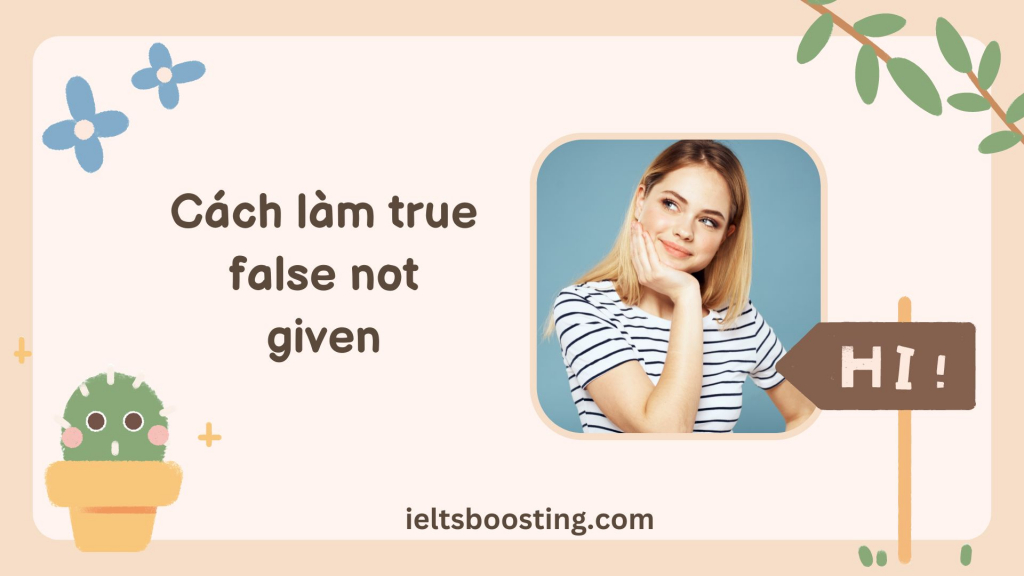Cách làm true false not given là bài viết hướng dẫn cách làm dạng bài True/False/Not Given hoặc Yes/No/Not Given. Dạn bài này thường được coi là khá khó khăn do những câu hỏi này đọc vào thấy gần nghĩa hoặc mơ hồ với nội dung trong bài. Bài viết này sẽ giới thiệu các kỹ năng đọc cần có để bạn có thể tìm kiếm thông tin chính xác trong bài đọc, cũng như đưa ra các chiến lược và ví dụ mẫu giúp bạn vượt qua dạng câu hỏi này với điểm số tối đa.

cách làm true false not given
Phân biệt True/False/Not Given và Yes/No/Not Given
Dạng bài True/False/Not Given và Yes/No/Not Given đều yêu cầu thí sinh xác định rằng thông tin trong câu hỏi và bài đọc có chính xác, trái ngược hoặc không được đề cập trong bài.
Thông thường, dạng bài này sẽ có hai loại câu hỏi:
True/False/Not Given
Dựa vào những thông tin được cung cấp trong bài True/False/Not Given yêu cầu xác định xem nội dung câu trả lời trùng khớp, hay trái ngược với thông tin trong bài
- True: Thông tin trong câu hỏi trùng khớp với thông tin cung cấp từ bài đọc
- False: Thông tin trong câu hỏi trái ngược với thông tin cung cấp từ bài đọc
- Not Given: Thông tin hoàn toàn không được đề cập trong bài đọc.
Dấu hiệu nhận biết: Do the following statements agree with the information given in the text/reading…?
Yes/No/Not Given
Dựa vào những thông tin được cung cấp trong bài, bạn sẽ lựa chọn giữa Yes/No/Not Given nhằm đánh giá câu hỏi có trùng khớp với quan điểm, ý kiến của tác giả.
- Yes: Thông tin trong câu hỏi đúng với ý kiến, quan điểm của tác giả
- No: Thông tin trong câu hỏi trái ngược với ý kiến, quan điểm của tác giả
- Not Given: Không nắm bắt được quan điểm của người viết.
Dấu hiệu nhận biết: Do the following statements agree with the claims/views of the writer in Reading…?
Cách làm true false not given

Cách làm true false not given
Một số lưu ý khi làm dạng bài true false not given
- Thông tin trả lời cho các câu hỏi sẽ được xuất hiện theo thứ tự nên không cần phải đọc và gạch chân từ khóa cùng lúc tất cả các câu trả lời mà ưu tiên làm câu 1 trước rồi theo thứ tự.
- So sách và đối chiếu thông tin thật kỹ, nhưng cố gắng đừng để mất quá nhiều thời gian cho một câu hỏi. Do đó, nếu bạn mất hơn 2 phút mà vẫn chưa tìm thấy thông tin cung cấp trong bài, hãy điền ‘Not Given’.
Xem thêm: Các dạng bài reading ielts
Cùng áp dụng vào bài dưới đây
Making Time for Science
1. Chronobiology is the study of how living things have evolved over time.
Câu 1: Sinh học thời gian là nghiên cứu về cách các sinh vật sống phát triển theo thời gian.
So sánh với thông tin đoạn A: a field of study that concerns one of the oldest processes life on this planet has ever known: short-term rhythms of time and their effect on flora and fauna
Hai định nghĩa khác nhau nên đáp án là FALSE
2. The rise and fall of sea levels affect how sea creatures behave. (Sự lên xuống của mực nước biển ảnh hưởng đến hành vi của sinh vật biển)
So sánh với thông tin Marine life, for example, is influenced by tidal patterns
Nội dung của câu 2 và bài đọc trùng khớp nên đáp án là TRUE
3. Most animals are active during the daytime. (Phần lớn động vật hoạt động vào ban ngày)
Trong đoạn B có câu: Numerous creatures, humans included, are largely diurnal – that is, they like to come out during the hours of sunlight (nhưng không có ý MOST )
Hầu hết và nhiều là hai câu có ý khác nhau nên đáp án là NOT GIVEN (lưu ý dạng này hay bẫy chủ ngữ các nhau dẫn đến ý nghĩa khác nhau)
4. Circadian rhythms identify how we do different things on different days. (Nhịp sinh học xác định cách chúng ta làm những việc khác nhau vào những ngày khác nhau.)
So sánh với thông tin đoạn C When it comes to humans, chronobiologists are interested in what is known as the circadian rhythm. This is the complete cycle our bodies are naturally geared to undergo within the passage of a twenty-four hour day
Nhịp sinh học là chu trình hoàn chỉnh mà cơ thể chúng ta được chuẩn bị một cách tự nhiên để trải qua trong một ngày 24 giờ
Nội dung của 2 câu trái ngược nhau nên đáp án là FALSE
5. A ‘night person’ can still have a healthy circadian rhythm. (Một ‘người sống về đêm’ vẫn có thể có nhịp sinh học khỏe mạnh)
So sánh với thông tin đoạn C: Night people’, for example, often describe how they find it very hard to operate during the morning, but become alert and focused by evening. This is a benign variation within circadian rhythms known as a chronotype.
Nội dung healthy circadian rhythm và become alert and focused by evening. This is a benign variation trùng nhau nên đáp án là TRUE
6. New therapies can permanently change circadian rhythms without causing harm. (Các liệu pháp mới có thể thay đổi vĩnh viễn nhịp sinh học mà không gây hại.)
So sánh với nội dung trong đoạn D: Recent therapeutic developments for humans such as artificial light machines and melatonin administration can reset our circadian rhythms, for example, but our bodies can tell the difference and health suffers when we breach these natural rhythms for extended periods of time
Hai nội dung trái ngược nhau nên đáp án là FALSE
7. Naturally-produced vegetables have more nutritional value. (Rau sản xuất tự nhiên có nhiều giá trị dinh dưỡng hơn.
So sánh với thông tin trong đoạn D: studies demonstrate that vegetables grown in season and ripened on the tree are far higher in essential nutrients than those grown in greenhouses and ripened by laser.
Xem thêm: True false not given practice exercises
Hai nội dung cùng ý nghĩa nên đáp án là TRUE
Bài đọc
A.Chronobiology might sound a little futuristic – like something from a science fiction novel, perhaps – but it’s actually a field of study that concerns one of the oldest processes life on this planet has ever known: short-term rhythms of time and their effect on flora and fauna (câu 1)
B. This can take many forms. Marine life, for example, is influenced by tidal patterns (câu 2). Animals tend to be active or inactive depending on the position of the sun or moon. Numerous creatures, humans included, are largely diurnal – that is, they like to come out during the hours of sunlight. (câu 3) Nocturnal animals, such as bats and possums, prefer to forage by night. A third group are known as crepuscular: they thrive in the lowlight of dawn and dusk and remain inactive at other hours.
C.When it comes to humans, chronobiologists are interested in what is known as the circadian rhythm. This is the complete cycle our bodies are naturally geared to undergo within the passage of a twenty-four hour day (câu 4). Aside from sleeping at night and waking during the day, each cycle involves many other factors such as changes in blood pressure and body temperature. Not everyone has an identical circadian rhythm. ‘Night people’, for example, often describe how they find it very hard to operate during the morning, but become alert and focused by evening. This is a benign variation within circadian rhythms known as a chronotype. (câu 5)
D. Scientists have limited abilities to create durable modifications of chronobiological demands. Recent therapeutic developments for humans such as artificial light machines and melatonin administration can reset our circadian rhythms, for example, but our bodies can tell the difference and health suffers when we breach these natural rhythms for extended periods of time (câu 6). Plants appear no more malleable in this respect; studies demonstrate that vegetables grown in season and ripened on the tree are far higher in essential nutrients than those grown in greenhouses and ripened by laser.
Knowledge of chronobiological patterns can have many pragmatic implications for our day-to-day lives. While contemporary living can sometimes appear to subjugate biology – after all, who needs circadian rhythms when we have caffeine pills, energy drinks, shift work and cities that never sleep? – keeping in synch with our body clock is important.
The average urban resident, for example, rouses at the eye-blearing time of 6.04 a.m., which researchers believe to be far too early. One study found that even rising at 7.00 a.m. has deleterious effects on health unless exercise is performed for 30 minutes afterwards. The optimum moment has been whittled down to 7.22 a.m.; muscle aches, headaches and moodiness were reported to be lowest by participants in the study who awoke then.
Once you’re up and ready to go, what then? If you’re trying to shed some extra pounds, dieticians are adamant: never skip breakfast. This disorients your circadian rhythm and puts your body in starvation mode. The recommended course of action is to follow an intense workout with a carbohydrate-rich breakfast; the other way round and weight loss results are not as pronounced.
Morning is also great for breaking out the vitamins. Supplement absorption by the body is not temporal-dependent, but naturopath Pam Stone notes that the extra boost at breakfast helps us get energised for the day ahead. For improved absorption, Stone suggests pairing supplements with a food in which they are soluble and steering clear of caffeinated beverages. Finally, Stone warns to take care with storage; high potency is best for absorption, and warmth and humidity are known to deplete the potency of a supplement.
After-dinner espressos are becoming more of a tradition – we have the Italians to thank for that – but to prepare for a good night’s sleep we are better off putting the brakes on caffeine consumption as early as 3 p.m. With a seven hour half-life, a cup of coffee containing 90 mg of caffeine taken at this hour could still leave 45 mg of caffeine in your nervous system at ten o’clock that evening. It is essential that, by the time you are ready to sleep, your body is rid of all traces.
Evenings are important for winding down before sleep; however, dietician Geraldine Georgeou warns that an after-five carbohydrate-fast is more cultural myth than chronobiological demand. This will deprive your body of vital energy needs. Overloading your gut could lead to indigestion, though. Our digestive tracts do not shut down for the night entirely, but their work slows to a crawl as our bodies prepare for sleep. Consuming a modest snack should be entirely sufficient.


